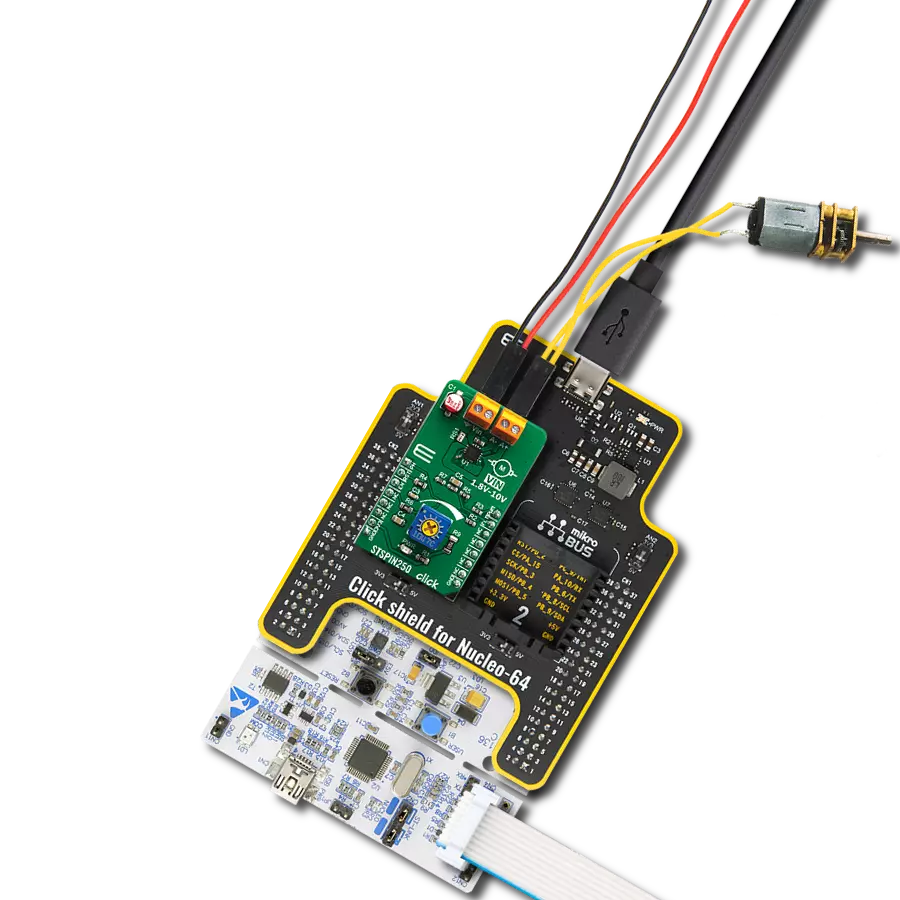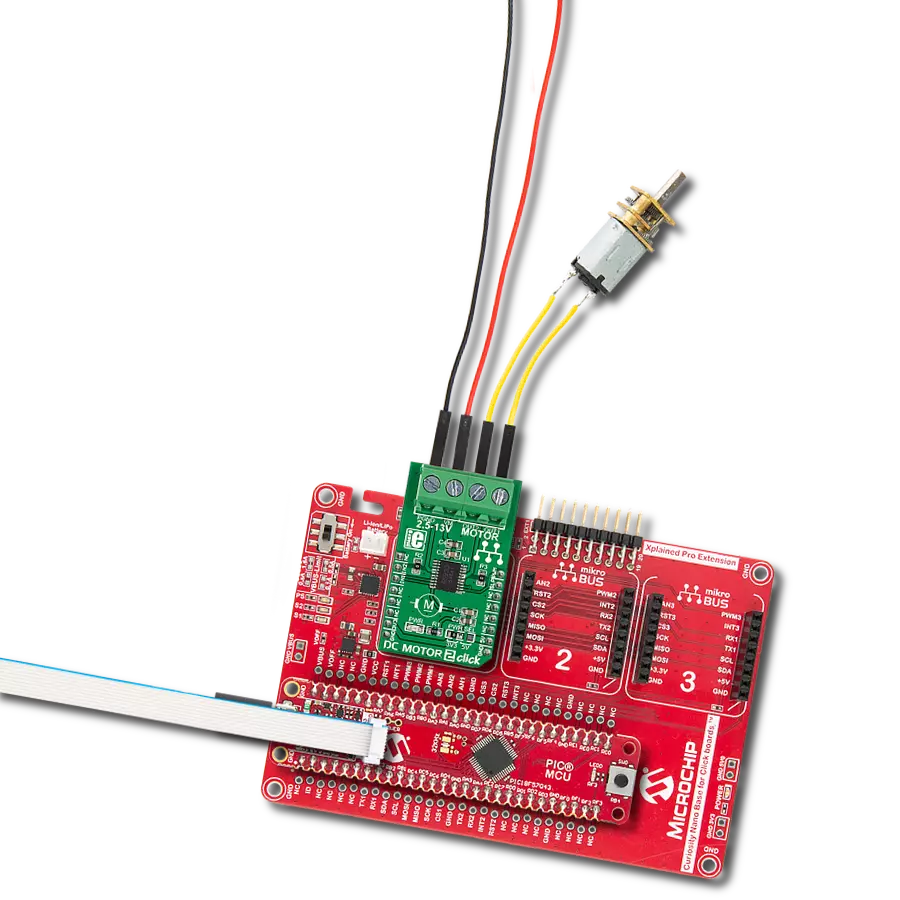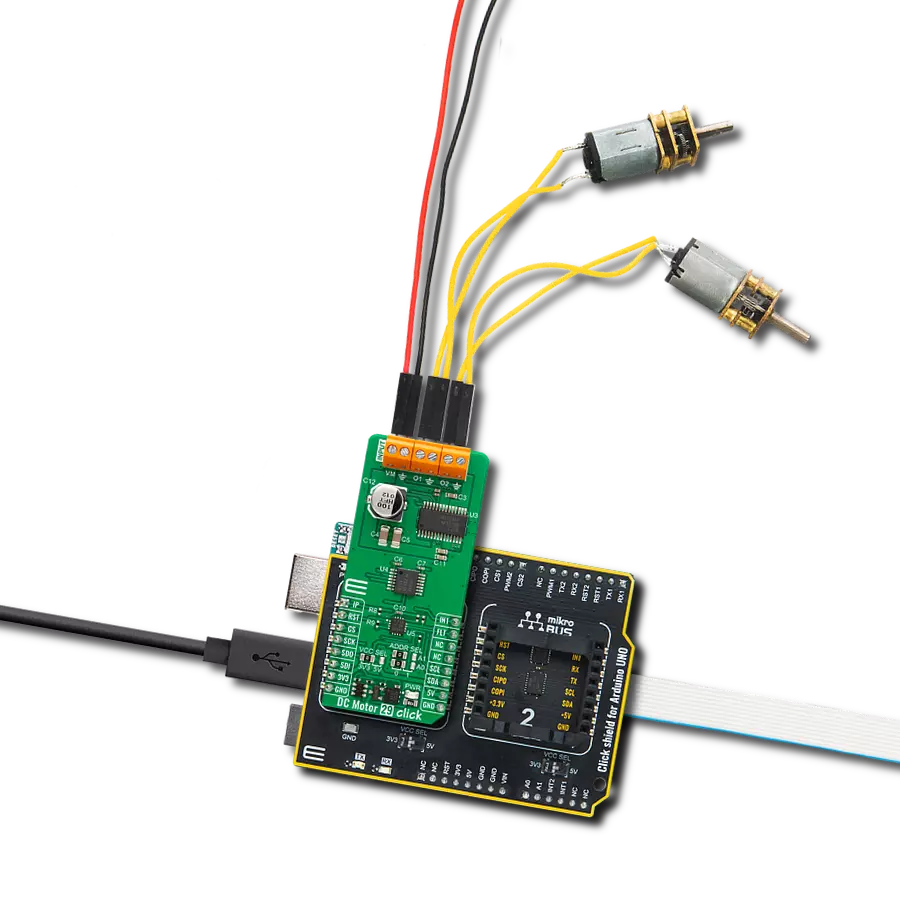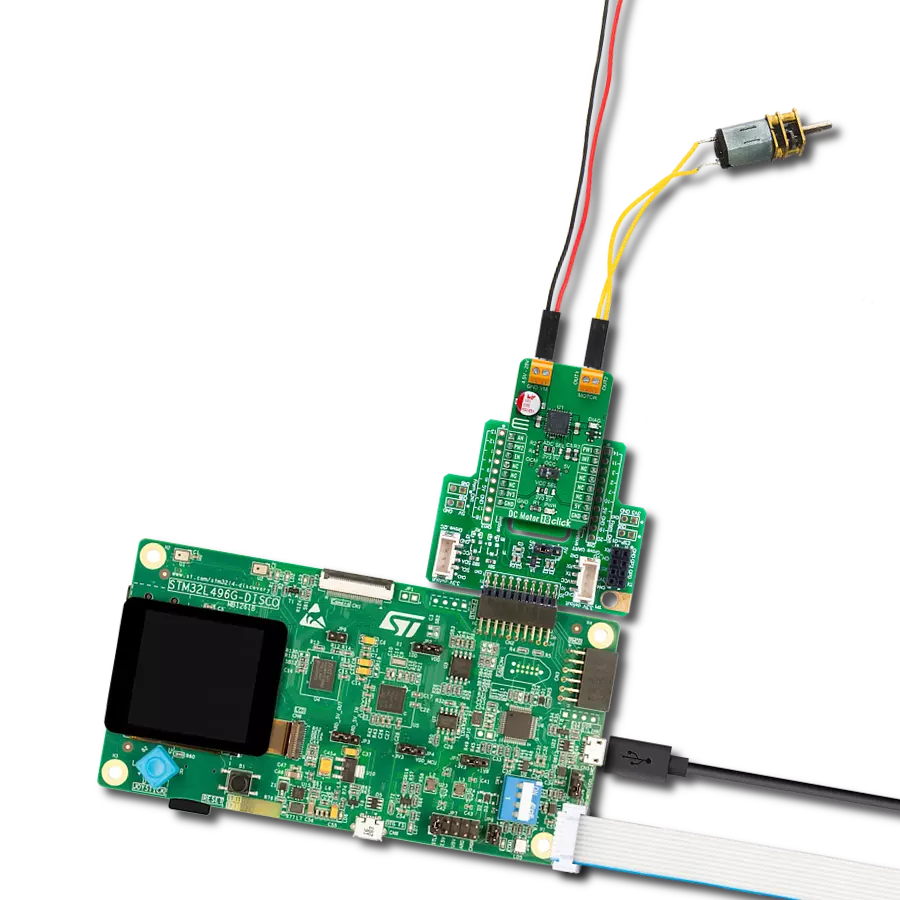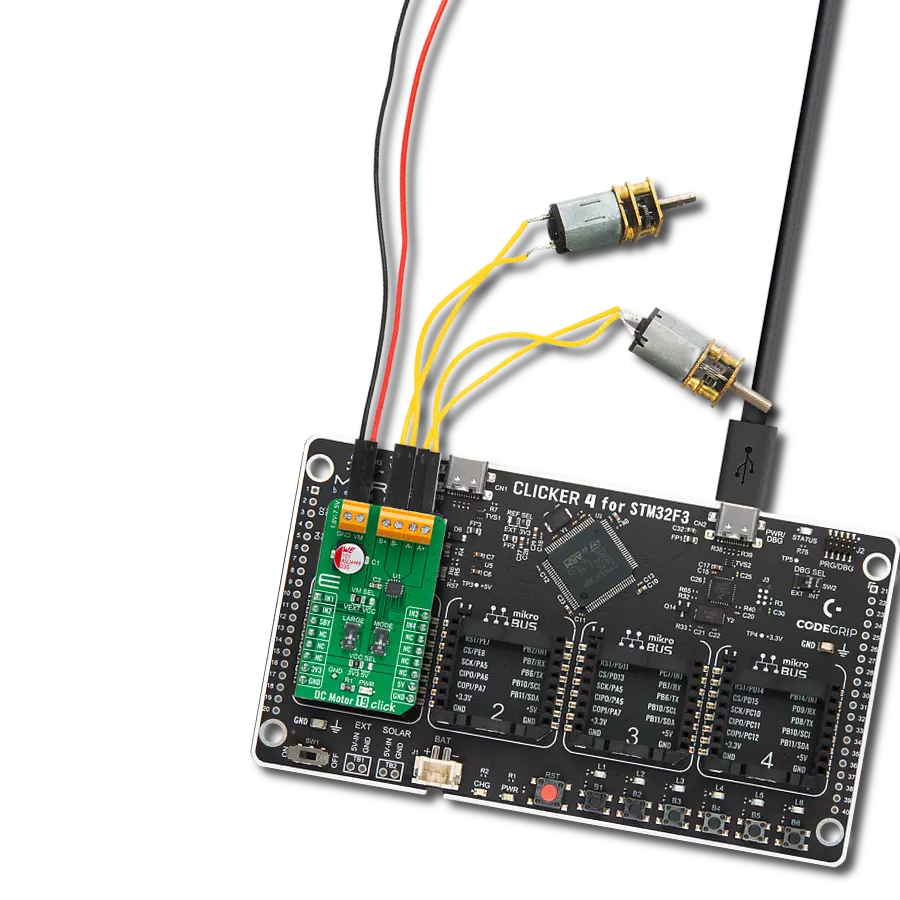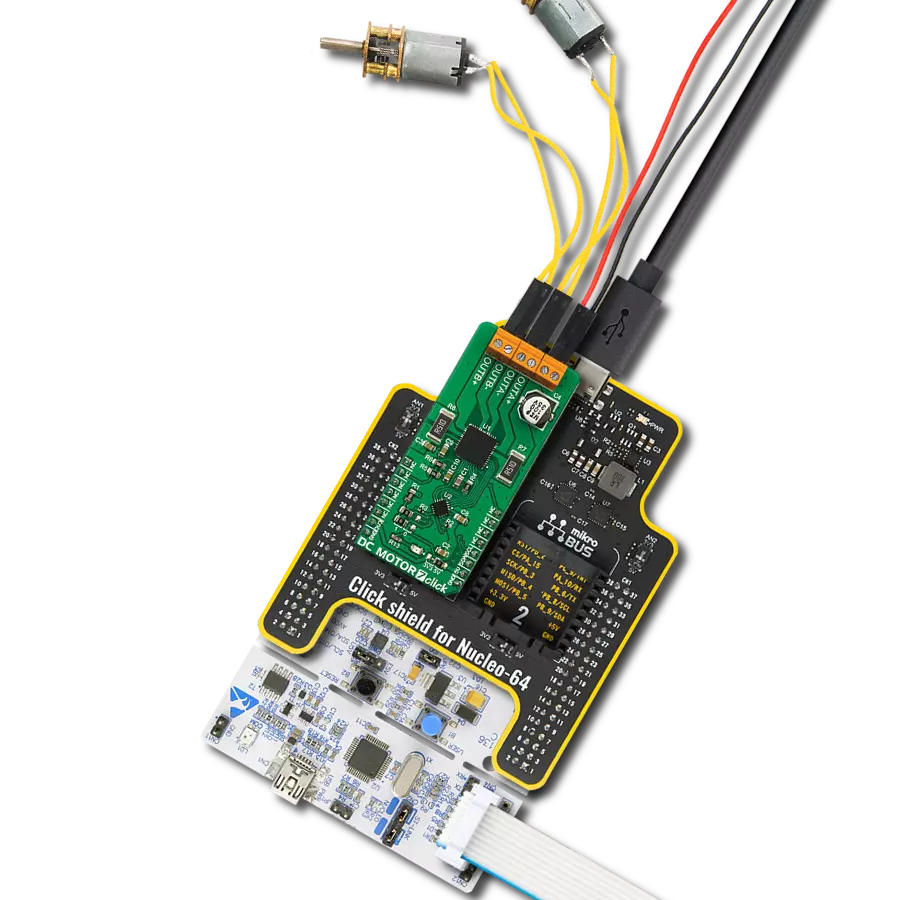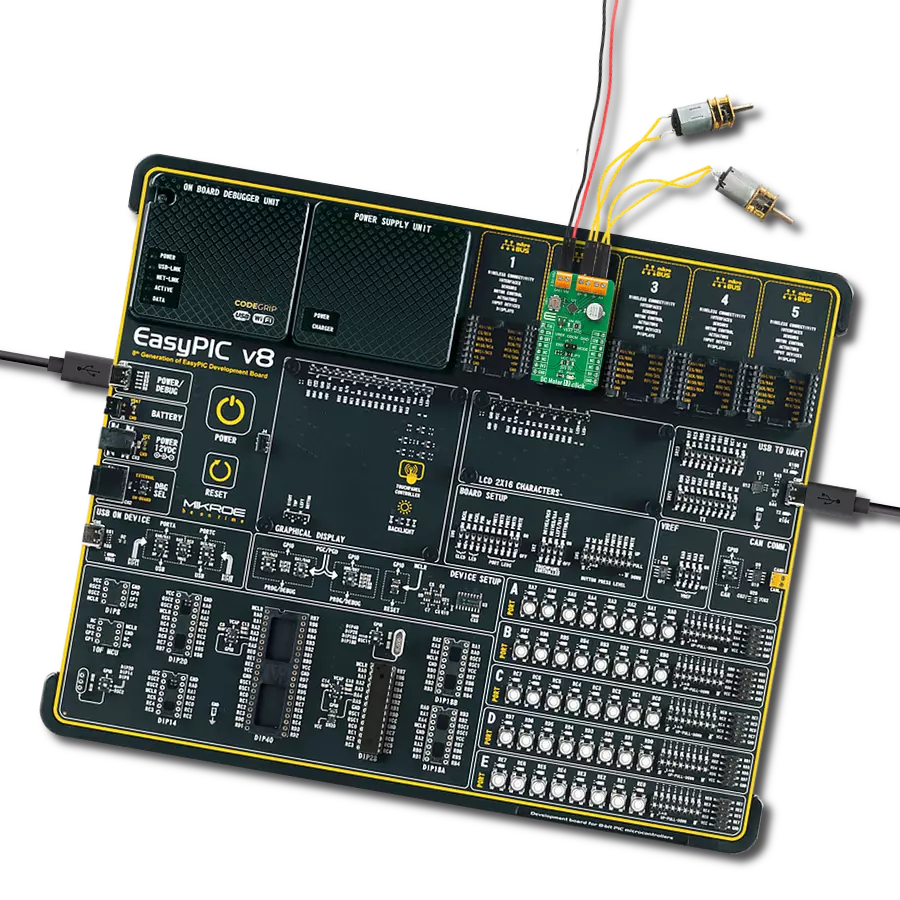Elevate your automotive experience with this advanced DC motor driving solution
A
A
Hardware Overview
How does it work?
H-Bridge 6 Click is based on the VNHD7008AY, a DC motor driver for automotive applications that integrates a fully protected dual high-side driver and protection for the external power MOSFETs from STMicroelectronics. This Click board™ can interface with the MCU to select the motor direction and the brake conditions via input signals on INA and INB pins but also possesses a MultiSense pin for a motor-current monitor. Two selection pins (SEL0 and SEL1) are available to address to the MCU the information from the MultiSense pin. It operates from a single power supply input labeled as VBATT in a range from 4V to 28V, which can be directly connected to a DC voltage supply. Also, this device is fully protected against supply under-voltage, output overcurrent, and device overtemperature events.
To Power-On the VNHD7008AY from Stand-By Mode,it is recommended to toggle INA, INB, SEL0, or SEL1 pins from 0 to 1 state to come out from Stand-By Mode. Also, toggle the PWM pin from 0 to 1 state with a delay of 20μs to avoid any overstress on the device in case of an existing short-to-battery situation. H-Bridge 6 Click communicates with MCU through a well-known 8-bit I/O expander, the PCA9538A from NXP Semiconductor, using the standard I2C 2-Wire interface with a maximum frequency of 400kHz. The VNHD7008AY also allows the choice of the least significant bit (LSB) of its I2C slave address by positioning SMD jumpers labeled as ADDR SEL to an appropriate position marked as 0 and 1. In addition to this feature, this Click board™ also contains additional functionalities routed to the PWM, AN, and RST pins on the mikroBUS™ socket.
The PWM pin, up to 20 kHz, allows to control of the speed of the motor in all possible conditions, while the AN pin labeled as MS allows monitoring of the motor current, provides a voltage proportional to the battery value, and the information on the temperature of the VNHD7008AY. The RST pin has retained its reset function by default. This Click board™ can operate with either 3.3V or 5V logic voltage levels selected via the VCC SEL jumper. This way, both 3.3V and 5V capable MCUs can use the communication lines properly. However, the Click board™ comes equipped with a library containing easy-to-use functions and an example code that can be used, as a reference, for further development.
Features overview
Development board
UNI-DS v8 is a development board specially designed for the needs of rapid development of embedded applications. It supports a wide range of microcontrollers, such as different STM32, Kinetis, TIVA, CEC, MSP, PIC, dsPIC, PIC32, and AVR MCUs regardless of their number of pins, and a broad set of unique functions, such as the first-ever embedded debugger/programmer over WiFi. The development board is well organized and designed so that the end-user has all the necessary elements, such as switches, buttons, indicators, connectors, and others, in one place. Thanks to innovative manufacturing technology, UNI-DS v8 provides a fluid and immersive working experience, allowing access anywhere and under any
circumstances at any time. Each part of the UNI-DS v8 development board contains the components necessary for the most efficient operation of the same board. An advanced integrated CODEGRIP programmer/debugger module offers many valuable programming/debugging options, including support for JTAG, SWD, and SWO Trace (Single Wire Output)), and seamless integration with the Mikroe software environment. Besides, it also includes a clean and regulated power supply module for the development board. It can use a wide range of external power sources, including a battery, an external 12V power supply, and a power source via the USB Type-C (USB-C) connector. Communication options such as USB-UART, USB
HOST/DEVICE, CAN (on the MCU card, if supported), and Ethernet is also included. In addition, it also has the well-established mikroBUS™ standard, a standardized socket for the MCU card (SiBRAIN standard), and two display options for the TFT board line of products and character-based LCD. UNI-DS v8 is an integral part of the Mikroe ecosystem for rapid development. Natively supported by Mikroe software tools, it covers many aspects of prototyping and development thanks to a considerable number of different Click boards™ (over a thousand boards), the number of which is growing every day.
Microcontroller Overview
MCU Card / MCU

Type
8th Generation
Architecture
ARM Cortex-M7
MCU Memory (KB)
1024
Silicon Vendor
STMicroelectronics
Pin count
100
RAM (Bytes)
327680
You complete me!
Accessories
DC Gear Motor - 430RPM (3-6V) represents an all-in-one combination of a motor and gearbox, where the addition of gear leads to a reduction of motor speed while increasing the torque output. This gear motor has a spur gearbox, making it a highly reliable solution for applications with lower torque and speed requirements. The most critical parameters for gear motors are speed, torque, and efficiency, which are, in this case, 520RPM with no load and 430RPM at maximum efficiency, alongside a current of 60mA and a torque of 50g.cm. Rated for a 3-6V operational voltage range and clockwise/counterclockwise rotation direction, this motor represents an excellent solution for many functions initially performed by brushed DC motors in robotics, medical equipment, electric door locks, and much more.
Used MCU Pins
mikroBUS™ mapper
Take a closer look
Click board™ Schematic

Step by step
Project assembly
Track your results in real time
Application Output
1. Application Output - In Debug mode, the 'Application Output' window enables real-time data monitoring, offering direct insight into execution results. Ensure proper data display by configuring the environment correctly using the provided tutorial.

2. UART Terminal - Use the UART Terminal to monitor data transmission via a USB to UART converter, allowing direct communication between the Click board™ and your development system. Configure the baud rate and other serial settings according to your project's requirements to ensure proper functionality. For step-by-step setup instructions, refer to the provided tutorial.

3. Plot Output - The Plot feature offers a powerful way to visualize real-time sensor data, enabling trend analysis, debugging, and comparison of multiple data points. To set it up correctly, follow the provided tutorial, which includes a step-by-step example of using the Plot feature to display Click board™ readings. To use the Plot feature in your code, use the function: plot(*insert_graph_name*, variable_name);. This is a general format, and it is up to the user to replace 'insert_graph_name' with the actual graph name and 'variable_name' with the parameter to be displayed.

Software Support
Library Description
This library contains API for H-Bridge 6 Click driver.
Key functions:
void hbridge6_generic_write ( uint8_t reg, uint8_t tx_data )- Generic write function.uint8_t hbridge6_generic_read ( uint8_t reg )- Generic read function.void hbridge6_set_direction ( uint8_t direction )- Set the direction function.
Open Source
Code example
The complete application code and a ready-to-use project are available through the NECTO Studio Package Manager for direct installation in the NECTO Studio. The application code can also be found on the MIKROE GitHub account.
/*!
* @file main.c
* @brief HBridge6 Click example
*
* # Description
* This is an example that demonstrates the use of H-Bridge 6 Click board.
*
* The demo application is composed of two sections :
*
* ## Application Init
* Initialization driver enables - I2C,
* reset the device and set default configuration,
* initialization and configure the PWM, also write log.
*
* ## Application Task
* It shows moving in the clockwise direction of rotation
* and moving in the counterclockwise direction of rotation
* from slow to fast speed.
* All data logs write on USB uart changes.
*
* @author Stefan Ilic
*
*/
#include "board.h"
#include "log.h"
#include "hbridge6.h"
static hbridge6_t hbridge6;
static log_t logger;
void application_init ( void ) {
log_cfg_t log_cfg; /**< Logger config object. */
hbridge6_cfg_t hbridge6_cfg; /**< Click config object. */
/**
* Logger initialization.
* Default baud rate: 115200
* Default log level: LOG_LEVEL_DEBUG
* @note If USB_UART_RX and USB_UART_TX
* are defined as HAL_PIN_NC, you will
* need to define them manually for log to work.
* See @b LOG_MAP_USB_UART macro definition for detailed explanation.
*/
LOG_MAP_USB_UART( log_cfg );
log_init( &logger, &log_cfg );
log_info( &logger, " Application Init " );
// Click initialization.
hbridge6_cfg_setup( &hbridge6_cfg );
HBRIDGE6_MAP_MIKROBUS( hbridge6_cfg, MIKROBUS_1 );
err_t init_flag = hbridge6_init( &hbridge6, &hbridge6_cfg );
if ( I2C_MASTER_ERROR == init_flag || PWM_ERROR == init_flag ) {
log_error( &logger, " Application Init Error. " );
log_info( &logger, " Please, run program again... " );
for ( ; ; );
}
log_printf( &logger, "-----------------------\r\n" );
log_printf( &logger, " Set default config. \r\n" );
log_printf( &logger, "-----------------------\r\n" );
hbridge6_default_cfg( &hbridge6 );
Delay_ms ( 100 );
log_info( &logger, " Application Task " );
}
void application_task ( void ) {
static int8_t duty_cnt = 1;
static int8_t duty_inc = 1;
float duty = 0;
log_printf( &logger, " Clockwise \r\n" );
log_printf( &logger, "-----------------------\r\n" );
hbridge6_set_direction( &hbridge6, HBRIDGE6_DIRECTION_CLOCKWISE );
while ( duty_cnt < 10 ) {
duty = duty_cnt / 10.0;
hbridge6_set_duty_cycle ( &hbridge6, duty );
Delay_ms ( 500 );
duty_cnt += duty_inc;
}
log_printf( &logger, " Brake \r\n" );
log_printf( &logger, "-----------------------\r\n" );
hbridge6_set_direction( &hbridge6, HBRIDGE6_DIRECTION_BRAKE );
duty_cnt = 1;
Delay_ms ( 1000 );
log_printf( &logger, " Counterclockwise \r\n" );
log_printf( &logger, "-----------------------\r\n" );
hbridge6_set_direction( &hbridge6, HBRIDGE6_DIRECTION_COUNTERCLOCKWISE );
while ( duty_cnt < 10 ) {
duty = duty_cnt / 10.0;
hbridge6_set_duty_cycle ( &hbridge6, duty );
Delay_ms ( 500 );
duty_cnt += duty_inc;
}
log_printf( &logger, " Brake \r\n" );
log_printf( &logger, "-----------------------\r\n" );
hbridge6_set_direction( &hbridge6, HBRIDGE6_DIRECTION_BRAKE );
duty_cnt = 1;
Delay_ms ( 1000 );
Delay_ms ( 1000 );
Delay_ms ( 1000 );
hbridge6_pwm_stop( &hbridge6 );
Delay_ms ( 1000 );
Delay_ms ( 1000 );
hbridge6_pwm_start( &hbridge6 );
}
int main ( void )
{
/* Do not remove this line or clock might not be set correctly. */
#ifdef PREINIT_SUPPORTED
preinit();
#endif
application_init( );
for ( ; ; )
{
application_task( );
}
return 0;
}
// ------------------------------------------------------------------------ END





















